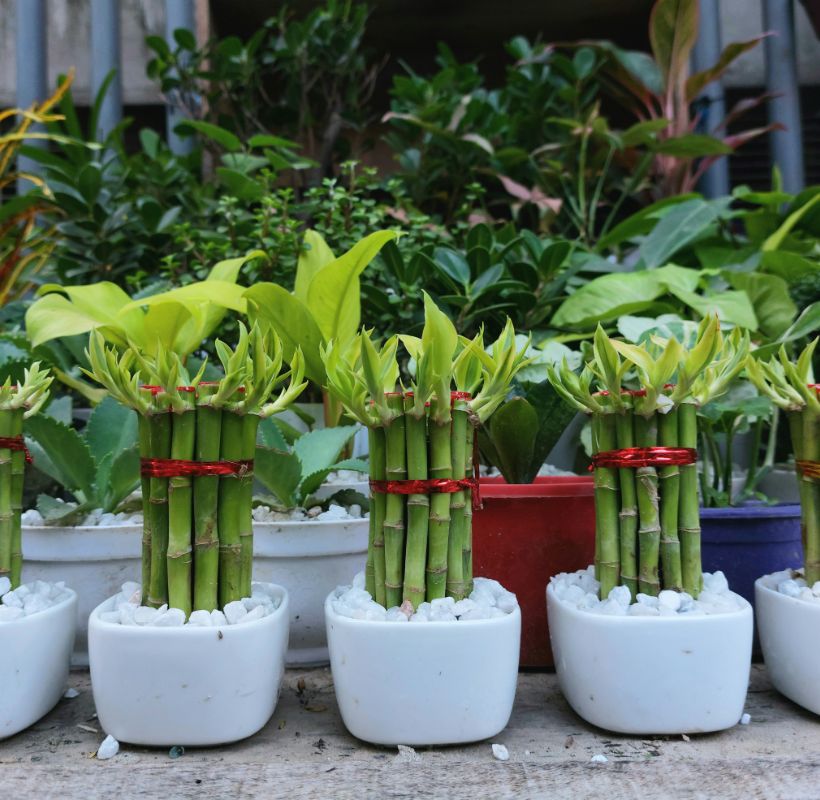Lucky Bamboo Benefits
Lucky Bamboo (Dracaena sanderiana) is a popular and easy-to-care-for plant that is widely believed to bring good fortune, prosperity to its owner. Native to Africa and Southeast Asia, Lucky Bamboo has become a favorite indoor plant due to its low-maintenance nature and its association. Whether you're looking to enhance the aesthetic of your home or attract good fortune, Lucky Bamboo is a perfect choice. In this article, we'll explore the benefits of Lucky Bamboo and provide a simple care guide to keep it thriving.
Benefits of Lucky Bamboo

Easy to Grow
Lucky Bamboo is one of the easiest plants to grow, making it an ideal choice for both novice gardeners and busy individuals. It doesn’t require soil to thrive and can grow in water or soil, making it a versatile and hassle-free plant for your home.
Why it’s easy:
It requires minimal light and can adapt to different environments.
Lucky Bamboo thrives in water with regular changes and occasional fertilization.
Tip: Choose a small glass vase or decorative container to grow your Lucky Bamboo in water. Add pebbles or small stones for support.
Purifies the Air
Like many other houseplants, Lucky Bamboo helps purify the air by absorbing toxins and releasing oxygen. It can help improve indoor air quality by filtering pollutants such as formaldehyde and benzene, creating a cleaner and healthier environment.
How it works:
Lucky Bamboo absorbs carbon dioxide and harmful chemicals from the air.
It contributes to the overall health of the space by increasing oxygen levels.
Tip: Place Lucky Bamboo in the areas where you spend the most time, like the living room or bedroom, for the best air-purifying benefits.
Low Maintenance and Long-Lasting
Lucky Bamboo is incredibly low-maintenance, making it an excellent choice for people with a busy lifestyle or for those who aren’t experienced with plant care. It doesn't require frequent watering, and its long-lasting nature means that you can enjoy its beauty for many years with minimal effort.
Why it’s low maintenance:
It only needs water changes every 1-2 weeks.
It thrives in indirect light, making it suitable for almost any indoor location.
Enhances Décor
With its elegant, long stems and vibrant green leaves, Lucky Bamboo adds a touch of calm and elegance to any room. It can complement various decor styles, from modern to traditional, and is often used as a centerpiece or decorative accent in living rooms, offices, and kitchens.
Design Tips:
Place it in a decorative container or vase to enhance its visual appeal.
Consider adding decorative stones or crystals to the base of the plant for extra charm.
How to Care for Your Lucky Bamboo
Lucky Bamboo is relatively easy to care for, but it still requires some attention to ensure it thrives. Follow these simple steps to keep your Lucky Bamboo healthy and beautiful.

1. Light Requirements
Lucky Bamboo thrives in bright, indirect light. It can tolerate lower light levels, but it grows best when exposed to filtered sunlight. Keep it out of direct sunlight to prevent the leaves from scorching.
Care Tips:
Place your plant near a window with sheer curtains or in a room with filtered light.
Avoid direct sunlight to prevent the leaves from becoming brown or yellow.
2. Watering
Lucky Bamboo can grow in either water or soil. When grown in water, it requires regular water changes to keep it fresh. When grown in soil, it needs to be watered once the top layer of soil feels dry.
Watering Tips:
Change the water in the vase every 1-2 weeks to keep it clean and prevent algae growth.
Ensure the water level is high enough to cover the roots, but not too high to drown the plant.
If growing in soil, water only when the soil is dry to the touch.
3. Soil or Water
You can grow Lucky Bamboo in either soil or water, depending on your preference. In water, it can thrive without soil, making it a unique and versatile plant.
Watering in Water:
Use distilled or purified water to avoid chlorine and fluoride found in tap water, which can harm the plant.
Place small stones or pebbles at the bottom of the vase to keep the stalks in place.
Watering in Soil:
Choose a well-draining potting mix for soil-based growth.
Water moderately and avoid waterlogging.
4. Temperature and Humidity
Lucky Bamboo prefers warm temperatures and moderate humidity levels. It thrives in temperatures between 65°F and 95°F (18°C to 35°C) and does best in environments that are neither too dry nor too humid.
Care Tips:
Avoid placing your plant near air conditioners, heaters, or cold drafts.
If the air in your home is very dry, you can occasionally mist the plant to maintain humidity.
5. Fertilizing
While Lucky Bamboo doesn’t require frequent fertilization, occasional feeding can help it grow stronger and more vibrant.
Fertilizing Tips:
Apply a diluted, balanced liquid fertilizer once a month during the growing season (spring and summer).
Avoid over-fertilizing, as too much fertilizer can damage the plant.
Common Problems and Solutions
Yellow Leaves: This is often a sign of overwatering, chlorine toxicity, or too much direct sunlight. Move your plant to a location with indirect light, change the water regularly, and avoid using tap water with chlorine.
Stunted Growth: If your Lucky Bamboo is not growing, it may not be getting enough light. Place it in a brighter area with indirect light.
Brown Tips: Brown tips may be caused by low humidity or inconsistent watering. Increase humidity or make sure to water the plant regularly.
Conclusion
Lucky Bamboo is not only an attractive plant. It offers numerous benefits, purifying the air, and improving the aesthetic appeal of any space. With its easy care and low-maintenance nature, Lucky Bamboo is the perfect plant for anyone looking to add a touch of elegance and positive energy to their home or office. By following the simple care tips outlined above, your Lucky Bamboo will thrive and bring good fortune for years to come.

